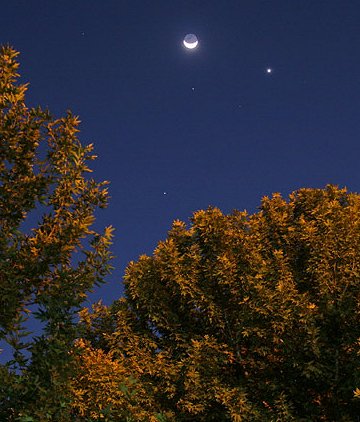 Where's Saturn? Is that a UFO--or the ISS? What's the name of that star? Get the answers from mySKY--a fun new astronomy helper from Meade. . Where's Saturn? Is that a UFO--or the ISS? What's the name of that star? Get the answers from mySKY--a fun new astronomy helper from Meade. . POLES APART: Something odd is happening to sunspot 972: its north and south magnetic poles are racing apart: movie. Often the spreading of magnetic poles signals the end of a sunspot. Could this active region dissolve less than 48 hours after it surfaced? You are now experiencing solar minimum. GOOD MORNING: This morning in Tehran, Iran, photographer Babak A. Tafreshi awoke to a scene of rare beauty. "The crescent Moon, dazzling Venus, Regulus and Saturn were gathered together in the deep blue early morning sky," he says. Golden autumn leaves added an extra dash of color: 
Photo details: Canon 20D, 400 ASA. More images: #1, #2, #3.
As daybreak progressed from the Middle East to Europe to the Americas, the Moon moved down through the Venus-Regulus-Saturn triangle. Browse the images below to see the geometry evolve. more images: from Gábor Szendrői of Gencsapáti, Hungary; from Dirk Peeters of Lille, Belgium; from Peter Heinzen of Moosalp, Switzerland; from Olivier Staiger near Geneva, Switzerland; from Mariano Ribas of Buenos Aires, Argentina; from Bob Betenia of Calgary, Alberta Canada; from Alberto Levy of Cabo San Lucas, Mexico; from Mark A. Brown of North of Carlisle, Pennsylvania; from Mark Wloch of Southgate, Michigan; from Leon Choin of Wonder Lake, Illinois; from Terry Mann of West Manchester, Ohio; from Darrell Spangler of Drake, Colorado. TIE FIGHTER: Lately, observers have been saying the International Space Station reminds them of a TIE Fighter. Here's why: 
Amateur astronomer Chris Todd of Ocean, New Jersey, took the picture last night through his hand-guided 8-inch Meade LX90. "It was an amazing space station flyover!" he says. The "wings" in Todd's picture are the station's copper-colored solar arrays, one of them newly unfurled giving the station a symmetrical fighter-like outline. Truly, however, there is no comparison: While a cramped Star Wars TIE Fighter could barely hold one Darth Vader, the International Space Station is large enough to house 3+ astronauts with room to spare for a science lab, a kitchen, a miniature gymnasium and more. It all adds up to a spaceship as bright as Venus. Later this month space shuttle Discovery will join ISS in Earth orbit. For one or two nights, as the shuttle prepares to dock with the larger space station, it will be possible to see and photograph the spacecraft side-by-side. When should you look? Check Heavens Above for flyby timetables or sign up for SpaceWeather PHONE to receive can't-miss alerts by phone and email.
September 2007 Aurora Gallery
[August 2007 Aurora Gallery] [Aurora Alerts] | 
